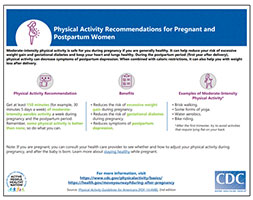Strength (or resistance) training aims to strengthen the musculoskeletal system. It can be accomplished using a person’s own body weight, free weights such as dumbbells or barbells, resistance bands, or machines. It is safe to continue resistance training throughout pregnancy without any adverse effects on growth and health of your baby, as long as you follow safety guidelines.
What are the benefits of resistance training? Resistance training helps support increased breast size, body weight and postural changes that occur during pregnancy. Abdominal and back strengthening helps prevent back pain – a very common ailment during pregnancy. Having a strong musculoskeletal system will make carrying your baby (and all that baby equipment) easier.
What should I avoid while resistance training? In general, most resistance training exercises that are safe for you to do outside of pregnancy are also safe during the first trimester, as long as they do not cause you pain. You should always avoid any exercise that causes you pain. As you progress through your second and third trimesters, avoid the following:
- Extending your hip past the neutral position (i.e., extending your leg(s) back behind you, such as during back extensions or the prone cobra position) – This can put extra tension on your pelvic ligaments, which are already getting stretched out to accommodate your baby.
- Lying flat on your back for prolonged periods of time – You may find you become dizzy or nauseated while lying on your back. If this happens, roll onto your left side and your symptoms should improve.
- Deep twisting/rotating through your torso – This puts undue strain on your pelvic ligaments.
- Valsalva (holding your breath and bearing down) – This is a technique often used by experienced weightlifters during exercises such as squats and deadlifts. During pregnancy, this will put extra tension and stress on your pelvic floor and abdominal wall, which is already getting stretched out from your growing uterus.
How often and for how long should I engage in resistance training? If you are new to resistance training, start with 20 – 30 minutes 1 to 2 days per week, engaging all major muscle groups (all body parts) each session. If you are accustomed to resistance training or enjoy it and wish to do it more frequently, it is generally safe to train for 30 – 60 minutes 4 to 6 days per week.
How intense or heavy should my resistance training be? You should be able to perform at least 10 – 12 repetitions of an exercise. If you are unable to, you should lighten the load. You will likely find that as you progress through your second trimester and into your third, you will need to decrease the intensity of your resistance training sessions. This is normal and expected.
Can I do crunches and other abdominal exercises? Crunches and all other abdominal exercises that are safe outside of pregnancy are generally safe during the first trimester and possibly early second trimester. Usually at some point during the second trimester, abdominal work needs to be modified to decrease stress on the abdominal wall as it becomes stretched with your expanding uterus.
Avoid any exercises or movements that cause “coning” or “doming” of the abdomen. You will likely find that coning/doming occurs if you try to perform crunch type exercises in your late second and third trimesters. Continuing this exercise puts you at higher risk of developing or worsening existing diastasis recti, which is a separation of the abdominal muscles down the midline.

 Print out and post this at-a-glance reminder on your refrigerator, desk or anywhere you look often.
Print out and post this at-a-glance reminder on your refrigerator, desk or anywhere you look often. 





